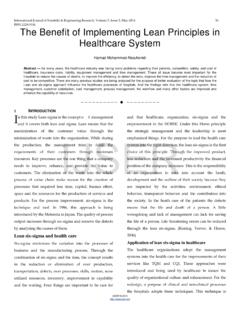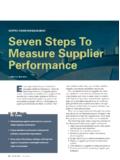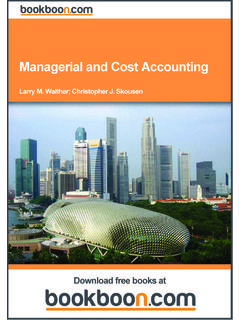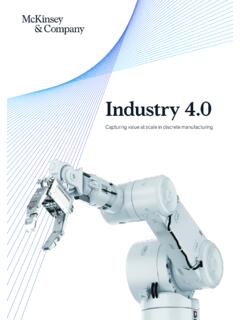Transcription of Efficiency and Innovation In U.S. Manufacturing Energy Use
1 Efficiency and Innovation In Manufacturing Energy Use TABLE OF CONTENTS ACKNOWLEDGMENTS INTRODUCTION EXECUTIVE SUMMARY .. 1 INDUSTRIAL Energy INTENSITY: CHALLENGE AND 3 Industrial Energy Trends .. 3 The Total Energy Profile of Manufactured o Case Study: Emerson .. 5 o Case Study: Toyota .. 5 Turning Challenges Into Opportunities ..6 o Case Study: Procter & Gamble .. 6 THE ROLE OF Energy IN Manufacturing .. 7 FACTORS THAT INFLUENCE INDUSTRIAL Energy 8 The Impact of Technology, Regulation and Market Forces .. 8 The Role of Energy Efficiency .. 9 o Case Study: Riverdale Mills 10 o Case Study: Ford Motor Company .. 11 o Case Study: 12 The Role of Government Policies and o Case Study: General Motors 13 The Role of Environmental 13 o Case Study: DENSO .. 14 o Case Study: Caterpillar .. 15 The Role of Technological Innovation .
2 15 o Case Study: Ingersoll-Rand .. 17 o Case Study: The Timken Company .. 17 o Case Study: Merck & Co.. 18 The Role of Managerial 19 o Case Study: 20 o Case Study: Kimberly-Clark Corporation .. 21 BARRIERS TO Energy Efficiency .. 21 INDUSTRIAL Energy MANAGEMENT: A CRITIQUE OF THE PREVAILING WISDOM .. 23 o Case Study: Mercury 25 INDUSTRIAL Energy Efficiency : LESSONS 25 Eight Attributes for Successful Energy o Case Study: 27 How To Start Managing Energy .. 27 business Impacts of Energy Efficiency .. 28 o Case Study: Shaw 28 APPENDIX A: Top R&D Opportunities for Energy Savings in Commodity/.. 30 Process Manufacturing , Initiatives That Provide the Largest Energy and Dollar Savings (Expanded Version) 31 ACKNOWLEDGMENTS The National Association of Manufacturers and The Manufacturing Institute, its research and education affiliate, have been advocates of Energy Efficiency for many years.
3 This is the third publication on this topic that we have developed since natural gas prices started their escalation at the beginning of the decade. This is the first time that we have partnered with the Alliance to Save Energy , however, and we turned to them at this time because of their expertise and three decades of knowledge about what works in spurring greater Energy Efficiency . We are grateful to Christopher Russell of the Alliance for authoring this publication and to Adam Hudson who assisted him in the writing and research. We also thank the many companies that have provided the invaluable insights into their operations and innovations that are making this a more Energy efficient economy. The sidebars about these companies that illustrate so many pages are true barometers of how extensive the interest is in Energy Efficiency today. We want to thank John Engler, president of the NAM, and Jerry Jasinowski, president of the institute, for making this publication on Energy Efficiency an important objective this spring for use during both the Energy Efficiency Forum in Washington, , and the World Expo in Nagoya, Japan.
4 Thanks also to Patrick Cleary, Bill Primosch and Laura Narvaiz for helping to shape the report. We are grateful to Marissa Gandelman for editing and her good suggestions on organization and clarity of the text, to Irina Stepanova for her cover design, to Kevin Sullivan and Ronni Hutchason for their production assistance, and to Jeanne Sano for arranging the translation, production and printing for the Japanese-language version released at the 2005 World Exposition in Nagoya, Japan. Thanks also to Bill Canis, executive director of the institute, who developed the concept for this booklet and shaped its evolution in conjunction with the Alliance. We are also grateful to Slade House, an intern with the institute, for assistance with research and writing about some of the companies profiled here. The Alliance to Save Energy does not endorse specific companies, products or services that are described in this report s case studies.
5 INTRODUCTION Industry uses more than one-third of the Energy consumed in the United States and even more when product transportation is factored in. The escalating costs for natural gas and oil clearly have a major impact for manufacturers in America that, left unaddressed, could hurt their competitiveness in world markets. Moreover, Energy experts predict that global market pressures on oil and gas markets will ensure that high prices will be with us for some time. The NAM has partnered with the Alliance to Save Energy to develop this booklet for manufacturers who want to achieve more strategic control over rising Energy costs. Being better Energy managers is important not only for each company, but is also an essential component in achieving a low-inflation, high-growth economy. We hope that the opportunities outlined in this booklet will encourage manufacturers to make Energy Efficiency a part of standard operating procedure.
6 Such investments in today s economy are well worth the effort. According to Department of Energy figures included in this report, industry can achieve practical Energy reductions of about 20 percent. These savings are worth almost $19 billion at 2004 Energy prices. About 30 percent of the savings can be achieved without capital investment, using only procedural and behavioral changes. One of the major findings of this report is that the rising costs for Energy also offer opportunities for manufacturers. By strategically building Energy Efficiency decision-making into production, manufacturers will identify new ways to cut costs, raise productivity, and improve shareholder value; improve managerial performance; meet environmental standards; create Energy efficient products and market opportunities; improve their competitive position; and ensure better community relations. We are releasing this publication in two places: at the Energy Efficiency Forum in Washington, , and also at the first world s fair of the 21st century, Expo 2005 in Aichi, Japan, because the expo s high-visibility theme is progress and the importance of man s relationship to the natural world.
7 This publication shows how manufacturers such as Caterpillar, Procter & Gamble, The Timken Company and Riverdale Mills are changing their processes to be more Energy efficient and using Innovation to bring forth a range of less Energy -consuming products. They are contributing to progress, while also reducing the environmental and Energy impact of product Manufacturing . We commend this booklet to all manufacturers who seek to be world-class competitors in a tough global market. John Engler Jerry Jasinowski President and CEO President National Association of Manufacturers The Manufacturing Institute EXECUTIVE SUMMARY Responding to rising Energy costs and the need to protect the environment, manufacturers have introduced a variety of innovative technologies, new business processes and enlightened management techniques to encourage greater Efficiency in the industrial use of Energy .
8 This report, which was prepared through a partnership of the National Association of Manufacturers (NAM) and Alliance to Save Energy (Alliance) highlights current challenges in industrial Energy use, examples of innovative practices by manufacturers and business strategies that are critical for the success of Energy -saving programs in today s competitive Manufacturing environment. Our research shows that effective strategies focus on the following key elements: Enhancing Financial Performance The recovery of wasted industrial Energy is an opportunity for manufacturers to improve financial performance in a globally competitive marketplace. Lack of Energy awareness, misinformation and conflicting priorities often result in manufacturers earnings literally going up in smoke. More than one-third of all Energy in the United States is used by industry; more than 40 percent if transport of manufactured goods is included.
9 Manufacturing facilities of all types, sizes and locations have the potential for Energy -driven productivity gains. Reduced Energy bills are only a start. Strategic deployment of Energy Efficiency is an indispensable component of any effort to improve productivity. Identifying Valuable Secondary Benefits Energy efficient practices are aligned with the principles of lean Manufacturing and continuous improvement. Industry s near-term Energy -saving opportunities come from Energy -smart procedures applied to current assets. In addition, there are a range of secondary benefits that come with a comprehensive Energy Efficiency strategy, including: Energy training and skills helps reduce the investment risk associated with new technologies; combustion volumes reduce proportionately with fossil fuel consumption, contributing to emissions compliance while also reducing Energy costs; and emerging business development opportunities related to environmentally superior products and production processes.
10 Evaluating Factors That Influence Energy Decisions In addition to how manufacturers implement Energy Efficiency in their facilities, other factors affect Energy use, such as government policies and programs, environmental regulations and technological and managerial innovations. The report evaluates these factors and their impact. Within most companies, there are also barriers to Energy Efficiency , ranging from lack of awareness to outmoded budgeting and accounting to lack of staff resources and skills. Similarly, the report s section titled Lessons Learned describes the attributes within a company that most often lead to success, such as a champion in the company to press for change, adoption of standards such as ISO 9000 and establishment of new criteria for fiscal and engineering decisions. -1- Applying Innovative Technology Improving staff training, businesses practices and management techniques can bring big increases in Energy Efficiency .

















